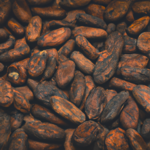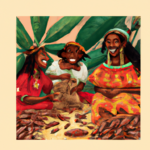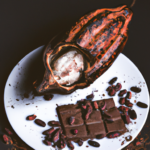Raw Food Ingredients
Why Eat Raw Cacao
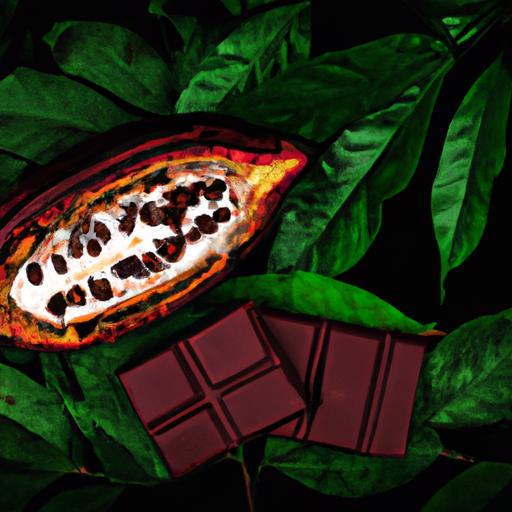
Oh, the pleasure of biting into a luxurious chocolate treat. The decadent, velvety goodness melting in my mouth, providing me with a unmatched sense of contentment. But what if I informed you that there is a method to enjoy this happiness while also fueling your body with a wealth of nutrients?
Enter raw cacao, nature’s gift to chocoholics like myself.
Raw cacao, derived from the cacao bean, has a long and storied history, dating back to ancient civilizations. It was revered for its medicinal properties and believed to be a source of divine energy. Today, modern science has confirmed what our ancestors knew all along – raw cacao is a nutritional treasure trove.
In this article, we will explore the incredible health benefits of raw cacao, its superiority over processed chocolate, and ways to incorporate it into your diet. From promoting skin health to aiding in weight management and enhancing exercise performance, raw cacao has a myriad of potential benefits. However, as with any good thing, there are also precautions to be aware of.
So, join me on this delectable journey as we uncover the wonders of raw cacao and why it deserves a spot in your pantry.
Key Takeaways
- Raw cacao boosts energy levels during workouts and improves performance and endurance.
- Consuming raw cacao promotes better blood circulation and reduces muscle soreness, aiding in recovery.
- Raw cacao improves cognitive function and focus, and can promote a positive mood.
- Raw cacao is packed with antioxidants, magnesium, iron, and fiber, supporting heart health and healthy digestion.
The History and Origins of Raw Cacao
The history of cacao cultivation dates back thousands of years to ancient civilizations in Mesoamerica. The Mayans and Aztecs considered cacao a sacred plant and used it for ceremonial purposes. They believed that cacao had mystical properties and even used cacao beans as currency.
The cultural significance of cacao continued into the European colonial period, where it became a popular drink among the elite. Today, raw cacao is enjoyed worldwide for its rich flavor and numerous health benefits.
Speaking of health benefits, let’s explore the nutritional benefits of raw cacao in the next section.
Nutritional Benefits of Raw Cacao
Indulging in the divine goodness of raw cacao is like unleashing a nutritional powerhouse that leaves your body buzzing with vitality. Raw cacao is not only delicious, but it also offers a plethora of health benefits. Here are four reasons why raw cacao is a must-have in your diet:
-
Rich in antioxidants: Raw cacao contains high levels of antioxidants, which help protect the body against free radicals and oxidative stress.
-
Mood booster: Consuming raw cacao can increase the production of neurotransmitters like serotonin and endorphins, promoting a positive mood and reducing stress.
-
Heart-healthy: Studies have shown that the flavonoids found in raw cacao can support cardiovascular health by reducing inflammation and improving blood flow.
-
Nutrient-dense: Raw cacao is packed with essential minerals such as magnesium, iron, and zinc, which are vital for various bodily functions.
However, it’s important to note that raw cacao also has potential side effects and precautions. Excessive consumption can lead to digestive issues, jitteriness, or even allergic reactions. It’s best to start with a small dosage and listen to your body.
Now, let’s delve into the comparison between raw cacao and processed chocolate.
Raw Cacao vs. Processed Chocolate
Discover the stark contrast between the divine richness of raw cacao and the processed chocolate that fails to match its nutritional prowess.
While processed chocolate may be a guilty pleasure, raw cacao stands out for its incredible health benefits.
Raw cacao is packed with antioxidants, which help fight against free radicals and reduce inflammation in the body. It is also a great source of magnesium, iron, and fiber.
Unlike processed chocolate, raw cacao retains its natural nutrients as it is minimally processed and does not contain added sugars or artificial ingredients.
Incorporating raw cacao into your diet can be as simple as adding it to smoothies, oatmeal, or even making your own healthy chocolate treats.
Transitioning into the next section, let’s explore some creative ways to enjoy the goodness of raw cacao in your everyday meals.
Ways to Incorporate Raw Cacao into Your Diet
Get ready to sprinkle some chocolatey magic into your meals with creative ways to infuse the velvety essence of raw cacao into your everyday dishes. Raw cacao is not only delicious, but it also offers numerous health benefits. One of the easiest ways to incorporate raw cacao into your diet is by making raw cacao smoothies. Simply blend together raw cacao powder, your choice of milk or non-dairy alternative, and your favorite fruits for a nutritious and indulgent treat. Another great option is to use raw cacao in desserts and treats. From raw cacao brownies to chocolate chia pudding, the possibilities are endless. To give you some inspiration, here’s a table with three mouthwatering recipes you can try:
| Recipe | Ingredients | Instructions |
|---|---|---|
| Raw Cacao Smoothie | 1 banana, 1 cup almond milk, 2 tbsp raw cacao powder | 1. Blend all ingredients together until smooth. |
| Raw Cacao Brownies | 1 cup dates, 1 cup walnuts, 1/4 cup raw cacao powder | 1. Blend dates and walnuts in a food processor until well combined. 2. Add raw cacao powder and pulse until the mixture becomes sticky. 3. Press the mixture into a baking dish and refrigerate. |
| Chocolate Chia Pudding | 1/4 cup chia seeds, 1 cup almond milk, 2 tbsp raw cacao powder | 1. Mix chia seeds, almond milk, and raw cacao powder in a bowl. 2. Let it sit for at least 30 minutes or overnight for a creamy pudding texture. |
Now that you have some delicious recipes to try, let’s explore how raw cacao can benefit your skin health.
Raw Cacao and Skin Health
Boost your skin’s health with the amazing benefits of incorporating raw cacao into your daily routine.
Raw cacao is packed with antioxidants that can help improve your skin’s appearance and overall health. These antioxidants help protect your skin from free radicals, which can cause premature aging and damage.
Raw cacao also contains vitamins and minerals that nourish your skin, promoting a healthy glow. Additionally, the flavonoids in raw cacao can enhance blood flow to the skin, resulting in improved skin tone and texture.
To reap the skin benefits of raw cacao, you can enjoy it in various forms, such as adding it to smoothies, making raw cacao desserts, or even using it as a face mask.
So, if you’re looking to enhance your skin’s health, incorporating raw cacao into your daily routine can be a delicious and effective option.
Next, let’s explore how raw cacao can aid in weight management.
Raw Cacao and Weight Management
Indulging in the rich and decadent flavors of raw cacao may not be the first thing you think of when it comes to managing your weight. But believe it or not, incorporating this delightful treat into your routine can actually help you shed those extra pounds.
Raw cacao contains compounds that can support weight loss and appetite control. Firstly, it is high in fiber, which helps you feel fuller for longer and reduces overeating. Additionally, raw cacao is rich in antioxidants called flavonoids. These flavonoids have been shown to boost metabolism and promote fat burning. They also have the ability to regulate blood sugar levels, preventing spikes and crashes that can lead to cravings and overeating.
So, if you’re looking to manage your weight, adding raw cacao to your diet can be a delicious and effective strategy.
Now, let’s explore how raw cacao can enhance exercise performance.
Raw Cacao and Exercise Performance
To maximize your exercise performance, incorporating the powerful benefits of raw cacao can significantly enhance your results. Raw cacao is packed with nutrients that can improve performance and enhance endurance. Here are some reasons why you should consider adding raw cacao to your exercise routine:
-
Increased energy: Raw cacao contains natural stimulants like caffeine and theobromine, which can boost your energy levels during workouts.
-
Improved blood flow: The flavonoids in raw cacao can promote better blood circulation, delivering oxygen and nutrients to your muscles more efficiently.
-
Enhanced focus: Raw cacao contains compounds that can improve cognitive function, helping you stay focused and mentally sharp during your workouts.
-
Reduced muscle soreness: The antioxidants in raw cacao have anti-inflammatory properties that can help reduce muscle soreness and aid in recovery.
Incorporating raw cacao into your exercise routine can have numerous benefits for improving performance and enhancing endurance. However, it’s important to be aware of potential side effects and take necessary precautions.
Potential Side Effects and Precautions
Be mindful of any potential side effects and take necessary precautions when incorporating raw cacao into your exercise routine.
While raw cacao is generally safe for consumption, it is important to note that some individuals may experience adverse reactions.
Potential risks associated with raw cacao include gastrointestinal issues such as stomach cramps, diarrhea, and nausea.
Additionally, raw cacao contains caffeine and theobromine, which can cause jitteriness, restlessness, and increased heart rate in sensitive individuals.
It is recommended to start with a small dosage and gradually increase it to assess your tolerance. It is also advisable to consult with a healthcare professional, especially if you have any existing medical conditions or are taking medications.
By being aware of these potential side effects and following appropriate dosage recommendations, you can safely incorporate raw cacao into your exercise routine.
Moving forward, let’s explore where to buy raw cacao products.
Where to Buy Raw Cacao Products
You’ll find a wide selection of tantalizing raw cacao products available for purchase at various specialty health food stores and online retailers. When it comes to finding raw cacao online, there are plenty of options to choose from. Websites like Amazon, Thrive Market, and Vitacost offer a range of raw cacao products, including raw cacao powder, nibs, and bars. These online platforms provide convenience and accessibility, allowing you to explore different brands and compare prices with just a few clicks.
Raw cacao products are not only delicious but also offer numerous benefits for overall well-being. They are packed with antioxidants, which help fight inflammation and protect against free radicals. Raw cacao is also a good source of magnesium, iron, and fiber, which can support healthy digestion and boost energy levels. Incorporating raw cacao into your diet can promote a positive mood, enhance cognitive function, and even improve heart health.
When purchasing raw cacao products, it’s essential to ensure they are sourced from reputable brands and produced using sustainable and fair trade practices. Reading customer reviews and checking for certifications like organic or fair trade can help you make informed choices. So go ahead and indulge in the goodness of raw cacao, knowing that it not only tastes great but also contributes to your overall well-being.
| Reasons to Buy Raw Cacao Online |
|---|
| Convenient shopping experience |
| Wide selection of products |
| Ability to compare prices |
| Access to customer reviews |
| Fast and reliable delivery |
Frequently Asked Questions
Are there any specific raw cacao products recommended for children?
As a parent, I understand the struggle of introducing new foods to picky eaters. Interestingly, studies have shown that toddlers who are introduced to raw cacao early on are more likely to develop a taste for it.
Can raw cacao help with menstrual cramps and PMS symptoms?
Raw cacao can help with menstrual cramps and PMS symptoms by enhancing mood and promoting hormonal balance. Its natural compounds, like magnesium and flavonoids, have been shown to reduce pain and improve mood during menstruation.
Is it safe to consume raw cacao during pregnancy?
It is generally safe to consume raw cacao during pregnancy, but it’s important to moderate intake. Raw cacao contains caffeine and other stimulants, which may affect fetal development. Consult with your healthcare provider for personalized advice.
Are there any specific raw cacao recipes for people with food allergies?
If you have food allergies, fear not! There are plenty of delicious raw cacao recipes out there that cater to your needs. From allergy-friendly raw cacao desserts to nutrient-packed smoothies, the options are endless. Indulge without worry!
Can raw cacao be used as a natural remedy for migraines and headaches?
Raw cacao can be used as a natural remedy for migraines and headaches. It contains compounds that can help relax blood vessels and reduce inflammation, which are common causes of these conditions.
What are the Benefits of Raw Cacao Compared to Ora Cacao?
When exploring the benefits of raw cacao, it’s important to note that raw cacao has higher levels of antioxidants, fiber, and nutrients compared to ora cacao. Raw cacao is also less processed, retaining more of its natural health benefits. Making the switch to raw cacao can lead to improved overall well-being.
Conclusion
In conclusion, my journey with raw cacao has been delightful and enlightening. This ancient treasure has satisfied my taste buds and nourished my body and soul. Raw cacao has a rich history and countless health benefits. It is truly a superfood. Incorporating raw cacao into my diet has improved my skin health, helped with weight management, and enhanced exercise performance. However, it’s important to enjoy raw cacao in moderation and be aware of any potential side effects. So, let’s embark on this delicious adventure and savor the wonders of raw cacao.
Rachael, the Editor in Chief of RachaelsRawFood.com, is an inspiring and passionate individual who has dedicated her life to promoting the benefits of a raw food lifestyle. Known for her vibrant and energetic personality, Rachael has built a strong online presence that has transformed her personal journey into a thriving community of raw food enthusiasts.
Raw Food Ingredients
How Much Caffeine in Cocoa?
Not all cocoa products are created equal when it comes to caffeine content – discover which one might surprise you!

When evaluating the caffeine levels in cocoa, it’s important to recognize that dark chocolate contains around 43 mg of caffeine per 100 grams due to its high cocoa solid content. Dark chocolate has a higher caffeine content compared to milk or white chocolate. This means that consuming dark chocolate in moderation can assist in managing your caffeine intake. On the other hand, milk chocolate has around 20 mg of caffeine per 100 grams while white chocolate is caffeine-free. Cocoa powder, commonly used in baking and beverages, contains a substantial 230 mg of caffeine per 100 grams. Being aware of these distinctions in chocolates can help you make informed decisions about your caffeine consumption.
Key Takeaways
- Caffeine content in cocoa varies based on cocoa solid concentrations.
- Unsweetened cocoa powder can contain around 230 mg of caffeine per 100 grams.
- Roasting cocoa solids influences the final caffeine content in cocoa products.
- Dark chocolate, with high cocoa solid content, has more caffeine than milk chocolate.
- Moderate consumption of cocoa products helps manage caffeine intake.
Caffeine Content in Dark Chocolate
Dark chocolate boasts a caffeine content of approximately 43 mg per 100 grams, mainly deriving from its higher cocoa solid composition. When we indulge in this decadent treat, we aren't only savoring its rich cocoa flavor but also a subtle caffeine kick. Compared to milk or white chocolate, dark chocolate contains a higher amount of caffeine.
Please bear in mind that moderate consumption of dark chocolate can assist individuals in managing their caffeine intake effectively. The caffeine levels in dark chocolate are about one-fourth of what you'd find in a standard cup of coffee. So, if you're looking for a milder caffeine boost, a piece of dark chocolate might just do the trick without the jitters that sometimes accompany a strong cup of coffee.
Enjoy your dark chocolate in moderation, savoring both its taste and the gentle pick-me-up it provides.
Caffeine Levels in Milk Chocolate

Milk chocolate, known for its creamy texture and sweet flavor, contains a modest caffeine content of approximately 5.6 mg per ounce, as indicated by USDA data. Unlike dark chocolate, milk chocolate has a lighter color due to lower cocoa content, resulting in reduced caffeine levels.
The delightful creamy taste in milk chocolate comes from a harmonious blend of cocoa and milk powder. While dark chocolate boasts higher caffeine content, milk chocolate remains a popular choice for those seeking a sweet treat with minimal caffeine intake.
Caffeine Presence in White Chocolate
With its unique composition excluding cocoa solids, white chocolate stands out as a caffeine-free alternative to its darker counterparts. White chocolate is crafted from a blend of cocoa butter, milk powder, sugar, and vanilla, making it a delectable treat without the stimulating effects of caffeine. For individuals sensitive to caffeine, white chocolate offers a creamy texture and indulgent flavor without the worry of unwanted side effects. This makes it a popular choice for desserts among those looking to steer clear of caffeine in their sweet treats.
Compared to dark chocolate, which contains cocoa solids and hence caffeine, white chocolate provides a caffeine-free option for those seeking a more mellow indulgence. So, if you're in the mood for a luscious and smooth chocolate experience without the buzz of caffeine, white chocolate is the perfect choice for your next dessert delight.
Impact of Cocoa Solids on Caffeine

In determining the caffeine levels in cocoa products, the percentage of cocoa solids plays a significant role. Here are some key points about the impact of cocoa solids on caffeine content:
- Caffeine Derivation: The caffeine content in cocoa primarily comes from cocoa solids, making it an important factor in determining the overall caffeine levels in cocoa-based products.
- Dark Chocolate: Dark chocolate, known for its higher cocoa solid content, tends to contain more caffeine compared to milk or white chocolate varieties due to this higher concentration.
- Unsweetened Cocoa Powder: A 100g serving of unsweetened cocoa powder can contain around 230mg of caffeine, reflecting the impact of the high cocoa solid content in this form.
- Health Benefits: The roasting process of cocoa solids not only affects the flavor profile but also influences the caffeine content, contributing to the potential health benefits associated with consuming cocoa products like hot cocoa.
Comparing Caffeine in Different Chocolates
Comparing the caffeine content in different chocolates reveals varying levels based on their cocoa solid concentrations. Dark chocolate contains about 43 mg of caffeine per 100 grams, making it a stronger caffeinated option compared to milk chocolate, which only has around 20 mg per 100 grams.
Surprisingly, white chocolate, derived from cocoa butter, doesn't contain any caffeine at all. For those seeking a more potent caffeine kick, cocoa powder is the way to go, boasting a high concentration of 230 mg per 100 grams.
The amount of caffeine in chocolate products is closely linked to the cocoa solid content, with dark chocolate containing the highest levels. So, the next time you're craving a chocolate treat but also need a little energy boost, opt for dark chocolate to get the most caffeine per bite.
Frequently Asked Questions
Is There More Caffeine in Cocoa Than Coffee?
There's more caffeine in cocoa than in coffee. Cocoa powder packs 230 mg per 100 grams, surpassing most coffee varieties. Dark chocolate has even more caffeine due to higher cocoa content. It's a rich, unique energy source.
Is There a Lot of Caffeine in Hot Cocoa?
There isn't a lot of caffeine in hot cocoa. It depends on the brand and recipe. Starbucks hot chocolate has around 25 mg per serving, while basic mixes have about 5 mg. The amount of cocoa powder used influences the caffeine content.
Is There Caffeine in Hershey's Cocoa?
Absolutely, Hershey's Cocoa does contain caffeine, but it's not overwhelming. It adds a delightful hint of energy in each spoonful. Perfect for baking or a cozy cup of hot chocolate. Just the right amount!
Is Cocoa a Stimulant Like Caffeine?
Cocoa stimulates like caffeine due to its theobromine content. Decaf versions offer a solution for caffeine-sensitive folks. Options include regular cocoa with caffeine, Dutch-processed cocoa with less, and decaf cocoa with reduced caffeine while keeping healthful compounds.
What are the potential health effects of consuming high levels of caffeine in cocoa?
Unveiling cocoa caffeine levels can lead to potential health effects of excessive consumption. High levels of caffeine in cocoa may contribute to insomnia, nervousness, and fast heartbeat. It can also cause gastrointestinal discomfort and exacerbate anxiety disorders. Moderation in consuming caffeinated cocoa products is recommended for overall health.
Conclusion
To sum up, the caffeine content in cocoa varies depending on the type of chocolate. Dark chocolate typically has the highest caffeine levels, followed by milk chocolate and white chocolate. The amount of cocoa solids in the chocolate also affects the caffeine content.
Remember, just like different chocolates have different levels of caffeine, we all have unique strengths and abilities. Embrace your individuality and always aim for balance in everything you do.
Rachael, the Editor in Chief of RachaelsRawFood.com, is an inspiring and passionate individual who has dedicated her life to promoting the benefits of a raw food lifestyle. Known for her vibrant and energetic personality, Rachael has built a strong online presence that has transformed her personal journey into a thriving community of raw food enthusiasts.
Raw Food Ingredients
5 Key Differences: Caffeine Content in Cocoa Vs Coffee
Open the door to understanding the contrasting caffeine levels in cocoa and coffee, revealing surprising insights that will reshape your beverage choices.

When comparing the caffeine levels in cocoa and coffee, it is important to understand that cocoa generally has lower caffeine content than coffee. Dark chocolate contains approximately 12 milligrams of caffeine per ounce, while hot cocoa typically ranges from 5 to 10 milligrams per ounce. In contrast, brewed coffee can have significantly higher levels, varying from 95 to 165 milligrams per 8-ounce cup.
Cocoa is considered a milder option for individuals aiming to limit their caffeine intake, with theobromine providing a gradual energy increase. Meanwhile, coffee's caffeine content offers immediate alertness, and understanding these distinctions can help you select based on your preferred effects.
Key Takeaways
- Cocoa contains lower caffeine levels but compensates with theobromine for a gradual energy increase.
- Coffee has higher caffeine content, offering an immediate alertness boost and potentially higher metabolic rate.
- Theobromine in cocoa promotes relaxation, while caffeine in coffee provides intense alertness and mood fluctuations.
- Hot chocolate is a good option for reducing caffeine intake while still benefiting from theobromine effects.
- Understanding caffeine variances helps make informed choices for desired energy levels and mood effects.
Caffeine Levels in Cocoa Vs Coffee
When comparing caffeine levels in cocoa versus coffee, it's evident that cocoa generally contains lower amounts per serving. Dark chocolate, made from cacao beans, contains around 12 milligrams of caffeine per ounce, while a 1-ounce serving of hot cocoa mix typically has 5-10 milligrams. Even a 16-ounce serving of Starbucks hot chocolate only contains about 25 milligrams of caffeine.
On the other hand, coffee, when brewed, can range from 95 to 165 milligrams of caffeine per 8-ounce cup, depending on the type and brewing method. This significant difference in caffeine content between cocoa and coffee makes cocoa a milder option for those looking to limit their caffeine intake.
Impact on Alertness and Energy

Typically, the immediate alertness and energy boost from caffeine in coffee can last for hours. This surge in alertness is due to caffeine's stimulating effect on the central nervous system. On the other hand, cocoa contains theobromine, which provides a more gradual increase in energy levels. Unlike caffeine, theobromine doesn't cause sudden spikes and crashes, offering a smoother energy curve.
Coffee's caffeine content can temporarily boost the metabolic rate, potentially supporting weight management efforts. This increased metabolic rate can aid in burning calories and may contribute to weight loss when combined with a balanced diet and regular exercise. Additionally, theobromine in cocoa contributes to the thermogenic effect, leading to mild calorie burning in the body.
Both caffeine and theobromine can influence mood. Caffeine tends to provide a more intense and quick-acting mood elevation, while theobromine promotes feelings of relaxation and contentment. Understanding the differences in alertness, energy, metabolic effects, and mood enhancements between cocoa and coffee can help individuals make informed choices based on their preferences and wellness goals.
Metabolic Variances and Effects
Regarding metabolic variances and effects, the varying caffeine levels between cocoa and coffee play a significant role. When comparing the metabolic impact of caffeine in cocoa and coffee, it is crucial to note that cocoa contains lower levels of caffeine but compensates with theobromine, which aids in the thermogenic effect, promoting calorie burning and metabolic activity. On the other hand, coffee, especially brewed varieties, contains higher levels of caffeine, potentially providing a temporary boost to the metabolic rate, which could assist in weight management. While caffeine in coffee offers a quick energy surge, theobromine in cocoa leads to a more gradual rise in energy levels, avoiding sudden spikes and crashes. To summarize the metabolic differences, I've created a table below:
| Aspect | Cocoa | Coffee |
|---|---|---|
| Caffeine Content | Lower levels | Higher levels |
| Additional Component | Theobromine | Caffeine |
| Metabolic Impact | Thermogenic effect | Temporary metabolic rate boost |
| Energy Levels | Gradual rise | Quick surge |
| Weight Management | Aids in calorie burning | Potential assistance |
Mood Enhancement Disparities

In comparing the mood enhancement effects of theobromine in cocoa and caffeine in coffee, notable disparities emerge in their impact on mental well-being.
The theobromine found in cocoa promotes relaxation and contentment, offering a gradual rise in energy levels that leads to a gentle and long-lasting mood enhancement experience.
On the other hand, caffeine delivers an intense and fast-acting boost in alertness, providing immediate energy levels that can lead to abrupt spikes and crashes.
While both theobromine and caffeine uplift mood, theobromine's effects are characterized by a steady and gradual increase in energy levels, creating a sense of calm and contentment.
In contrast, caffeine's impact is more intense and temporary, resulting in rapid alertness but also the potential for fluctuations in mood. Understanding these differences can help individuals choose between cocoa and coffee based on their desired mood enhancement effects.
Health Implications and Considerations
Health implications and considerations surrounding caffeine consumption warrant close attention due to its potential impact on various aspects of well-being. When comparing a cup of coffee to hot chocolate, it's vital to note the amount of caffeine present.
While coffee contains much caffeine, hot chocolate has less caffeine but isn't entirely devoid of it. The main active ingredients in hot chocolate are theobromine and caffeine, where theobromine is a relative of caffeine and also has stimulant effects, although milder. If you're looking to reduce your caffeine intake, opting for hot chocolate over a cup of coffee can be a good choice.
Being mindful of the caffeine content in chocolate products is important, especially if you're sensitive to caffeine or belong to vulnerable populations like children or pregnant women. Understanding the caffeine levels in different beverages allows you to make informed decisions about your consumption for better overall health.
Frequently Asked Questions
Is There Caffeine in Coffee Vs Cacao Powder?
Yes, there is caffeine in coffee, with around 140 milligrams in a 12-ounce cup. On the other hand, cacao powder contains only about 12 milligrams per tablespoon, making it a great caffeine-free alternative for those seeking a milder boost.
What Is the Difference Between Cocoa and Coffee?
When comparing cocoa and coffee, cocoa offers a rich, chocolatey flavor and is packed with antioxidants and minerals. Coffee, on the other hand, provides a robust, bitter taste and a jolt of caffeine for that morning pick-me-up.
Why Is Cocoa Better Than Coffee?
I believe cocoa is superior to coffee because it offers a gentler energy boost, promotes relaxation and contentment, and provides sustained vitality without sudden crashes. Plus, dark chocolate's theobromine supports cellular health and tastes delicious.
How Much Caffeine Is in Cocoa Powder Vs Decaf Coffee?
In cocoa powder vs decaf coffee, cocoa has 12-26mg of caffeine per tbsp, while decaf coffee holds 2-5mg per 8-ounce cup. The choice hinges on desired caffeine levels and flavor. I prefer cocoa's lower caffeine content.
How does the caffeine content in hot chocolate compare to coffee?
Hot chocolate caffeine content is significantly lower than that of coffee. While an 8-ounce cup of hot chocolate contains about 5-10 milligrams of caffeine, the same size of coffee can have anywhere from 95-200 milligrams. It’s a notable difference for those looking to limit their caffeine intake.
Conclusion
To sum up, while cocoa and coffee both contain caffeine, the levels vary significantly. Cocoa generally has lower caffeine content compared to coffee, impacting alertness, energy levels, and mood enhancement differently.
It's crucial to keep these differences in mind when choosing between the two beverages for your daily consumption. Remember, moderation is key to maintaining a healthy balance in your caffeine intake.
So, whether you prefer a cup of cocoa or a mug of coffee, enjoy it in moderation for the best benefits!
Rachael, the Editor in Chief of RachaelsRawFood.com, is an inspiring and passionate individual who has dedicated her life to promoting the benefits of a raw food lifestyle. Known for her vibrant and energetic personality, Rachael has built a strong online presence that has transformed her personal journey into a thriving community of raw food enthusiasts.
Raw Food Ingredients
A Guide to Becoming a Good King
Kingship demands wisdom, fairness, integrity, courage, and humility – essential traits for a successful reign and prosperous kingdom." Keep reading to uncover the secrets of becoming a good king.

In order to be a good king, one must embody wisdom, fairness, integrity, courage, and humility to lead the kingdom with honor. Wisdom is essential for making important decisions, fairness ensures just treatment for all, integrity builds trust and respect, courage is crucial for facing challenges, and humility reminds us of our humanity. Historical kings such as Solomon, Arthur, David, Charlemagne, and Ramses II serve as role models for these leadership traits.
As a king, embracing challenges, understanding the world, seeking personal growth, and learning from the past are essential responsibilities. Developing leadership skills, making wise decisions, and prioritizing the well-being of the people are key to effective kingship. Every step on the path to becoming a good king is critical for a successful reign and prosperous kingdom.
Key Takeaways
- Embrace wisdom for informed decisions.
- Practice fairness for just treatment.
- Uphold integrity to earn trust.
- Show courage in facing challenges.
- Maintain humility for empathy and respect.
Qualities of a Good King
Being a good king requires embodying qualities such as wisdom, fairness, integrity, courage, humility, and compassion in decision-making and leadership. Power comes with responsibility, and as a king, it's essential to wield this power wisely. Wisdom is vital in making sound judgments that benefit the kingdom as a whole. Fairness guarantees that all subjects are treated justly and equitably, fostering a harmonious society. Integrity is the foundation of trust and respect, key elements in effective leadership.
Courage is necessary to face challenges and make difficult decisions, even when met with opposition. Humility reminds a king of his humanity and the importance of humility in interactions with all subjects. Compassion demonstrates a king's care and empathy towards his people, fostering a sense of unity and loyalty. Effective communication is crucial for conveying decisions, listening to concerns, and inspiring confidence in leadership.
Historical Kings as Role Models

King Solomon, renowned for his wisdom and leadership, stands as an exemplar among historical kings who serve as role models for future leaders. Looking at figures like King Arthur, known for his justice and valor in medieval legends, and King David, celebrated for his faith and courage in battle, we find lessons that transcend time. Charlemagne's legacy of military conquests and cultural revival, alongside Ramses II's grand building projects and military campaigns, offer diverse insights into effective kingship. Below is a table summarizing key attributes of these historical kings:
| King | Attributes |
|---|---|
| King Solomon | Wisdom, leadership |
| King Arthur | Justice, valor |
| King David | Faith, courage |
| Charlemagne | Military prowess, culture revival |
| Ramses II | Building projects, military campaigns |
Studying these historical figures can provide valuable lessons on the multifaceted qualities that make a great ruler.
Responsibilities of Kingship
Embracing challenges and living authentically are central to fulfilling the responsibilities inherent in kingship. As men aspiring to be good kings, it's essential for us to understand that the world requires leaders who are kind, humble, and committed to personal growth.
The journey to becoming a good king involves more than just wielding power and responsibility—it entails sacrificing comfort for growth and transformation. Seeking the ancient path of masculinity, as exemplified by figures like Morgan, teaches us the importance of humility, vulnerability, and character development.
In fulfilling the responsibilities of kingship, we're entrusted with power not for our own gain, but for the betterment of the world around us. Just as seeds need Good Soil to flourish, we must nurture our own growth to lead effectively.
Leadership Skills for Kings

Developing essential leadership skills is crucial for aspiring kings seeking to fulfill their responsibilities with humility, vulnerability, and a focus on character development. As you study the world around us, the power and responsibility of what kingship entails become clearer. Here are some key points to think about on your path to becoming a king:
- Embrace challenges and live authentically.
- Seek ancient paths of masculinity for guidance.
- Reflect on your identity, purpose, and ability to be entrusted with power for good.
- Sacrifice comfort for growth, transformation, and participation in universal creativity.
The journey of becoming a king isn't just about gaining authority but about understanding the remarkable fellowship of like-hearted individuals who share similar goals. Engage in group discussion questions, consider between-session personal study, and explore the depths of your masculine soul. This is the path to restoring what it means to be a true king.
Importance of Wise Decision-Making
Steering through the intricacies of leadership, especially in the domain of kingship, requires a sharp focus on the art of prudent decision-making. Wise decision-making is like the compass guiding the ship of leadership towards success.
Good kings understand that their choices impact not just themselves but also the lives of those they rule over. They prioritize the well-being of their people over personal gains, embodying the essence of true leadership.
Seeking counsel from trusted advisors and reflecting on core values are essential practices in the domain of wise decision-making. By embracing humility and self-awareness, kings can navigate the complex web of choices with clarity and integrity.
Just like a six-session video Bible study can guide individuals in restoring the heart, wise decision-making is essential for becoming the kind of leaders our world needs. Let's start on this journey of radical reconstruction, where every decision is a step towards being counted among the good kings of history.
Frequently Asked Questions
What Is the Becoming a King Guide?
The Becoming a King guide is a transformative resource created by Morgan Snyder to help men grow into responsible kings. It offers practical tools and profound insights to aid personal development and transformation.
What Are the Qualities of a Good King?
Being a good king means embodying humility, wisdom, and integrity. Prioritizing the well-being of my people, making decisions for the greater good, and showing courage, justice, and compassion in all actions. Seeking counsel and valuing diverse perspectives is essential.
What Makes a True King?
Beneath the crown lies a heart that beats with humility and a spirit that soars with honor. True kings are forged in the fires of challenge, embracing authenticity and growth to inspire others.
What Makes a Real King?
Being a true king means embodying humility, courage, and empathy. It's about serving others and leading with integrity. I endeavor to cultivate these qualities daily, embracing challenges and seeking growth in all aspects of my life.
How Can Sacred Cacao be Incorporated Into Kingship Rituals?
In kingship rituals, the sacred cacao ritual holds great significance. The ceremonial drinking of cacao symbolizes the divine connection between the ruler and the spiritual realm. It is believed to impart wisdom and strength, making it a crucial element in the coronation and leadership rites of many cultures.
Conclusion
To sum up, becoming a good king requires a combination of qualities, skills, and responsibilities. Remember, 'With great power comes great responsibility.'
By studying historical kings as role models, practicing leadership skills, and making wise decisions, one can aspire to be a just and effective ruler.
It's a challenging path, but with dedication and perseverance, anyone can endeavor to be a worthy leader for their kingdom.
Rachael, the Editor in Chief of RachaelsRawFood.com, is an inspiring and passionate individual who has dedicated her life to promoting the benefits of a raw food lifestyle. Known for her vibrant and energetic personality, Rachael has built a strong online presence that has transformed her personal journey into a thriving community of raw food enthusiasts.
-

 Health and Wellness2 months ago
Health and Wellness2 months agoDoes Eating Raw Food Help You Lose Weight? Discover the Truth
-

 Raw Food Recipes2 months ago
Raw Food Recipes2 months agoHow Much Raw Food to Feed Your Puppy: Essential Tips
-

 Kitchen Essentials for Raw Food Preparation1 month ago
Kitchen Essentials for Raw Food Preparation1 month agoCan You Cook Raw Food in an Air Fryer? Discover the Possibilities
-

 Raw Food Recipes2 months ago
Raw Food Recipes2 months agoHow to Defrost Dog Raw Food Properly
-

 Health and Wellness2 months ago
Health and Wellness2 months agoHow Long Does It Take Bacteria to Spread From Raw Food? Essential Info
-
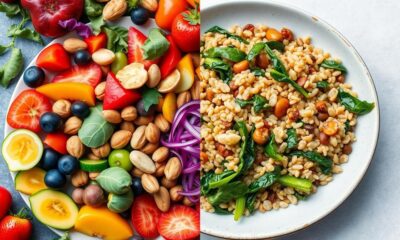
 Raw Food Recipes2 months ago
Raw Food Recipes2 months agoRaw Food Vs. Vegan: Which Diet Is Better?
-

 Raw Food Recipes2 months ago
Raw Food Recipes2 months agoIs Raw Food Good for Cats? Find Out Here
-

 Raw Food Recipes2 months ago
Raw Food Recipes2 months agoWhat Is the Raw Food Diet? A Comprehensive Overview


